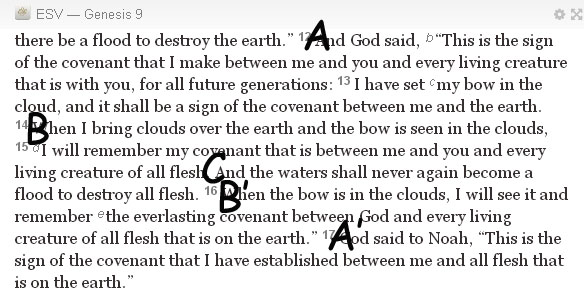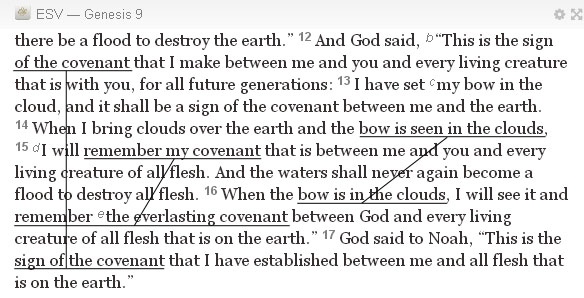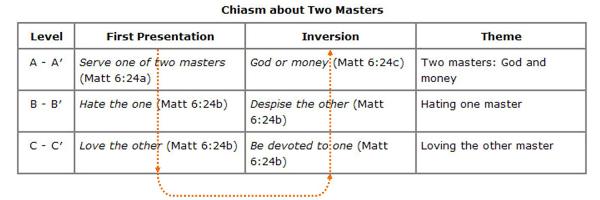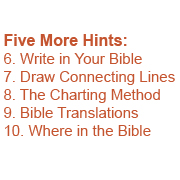Five More Hints for Finding Chiasms
Hopefully you are finding these hints helpful. Here are five more thoughts that may assist you in your search efforts:
6. Writing in Your Bible
Do you write in your Bible?
As I discover chiasms, I'll write the letters A and A′, or B and B′, etc. within the text at the beginning of each level.
I like the ESV Study Bible
because my pen does not bleed through.
I use a Pilot P-500 Extra Fine pen and find that works very well for me.
Caution: when selecting your next Bible, I don't recommend trying various translations with that pen at a Christian bookstore.
If I make a mistake, I write over the mistake or, if necessary, cross it out.
It's a little messy but it works for me.
I find that the analysis of literary structure is sometimes an iterative process; later discernments may help refine our initial understanding.

7. Draw Connecting Lines to Show Repeated Themes
I like to underline key words as I recognize patterns. Sometimes I will draw a straight line connecting the similar themes until I see the full pattern. I find that for some of the more difficult passages, this line drawing process is very helpful.

8. Take Advantage of the Charting Method
I like to use a charting method that to some may be cumbersome but it works very well for me. Please take a moment to compare this chart with the passage shown below the chart. Once you grasp this technique, this charting method should provide greater accuracy in your analysis of the many chiasms in the Bible.

| A | No one can serve two masters. | ||
| B | Either he will hate the one | ||
| C | and love the other, | ||
| C′ | or he will be devoted to the one | ||
| B′ | and despise the other. | ||
| A′ | You cannot serve both God and Money. | ||
| (Matt 6:24) | |||
When reading this chart, the verses under First Presentation are to be read from top to bottom,
while the verses under Inversion are to be read from bottom to top.
Each repeated thought or phrase is called a Theme.
There will always be two or more themes that, when combined together, are called a structure.
Each theme is assigned a level.
The conjugate pairs (e.g. B and B′) within each level are either similar to or opposite (antithetical) of each other.
In this chiasm, there are three levels, although there could be as few as two and as many as eight or ten or even higher.
In this charting method, the center point of emphasis is always displayed in the bottom row of the chart.
Also be aware that not all chiasms have a center point of emphasis;
for example, many of the A-B-B′-A′ chiasms in Proverbs do not reveal their importance in this manner.
I strongly recommend that you use this charting method when there is any question about the structure.
I have read many books about chiasms and only one author presents that method – I wish the others had.
Also, I don't agree with every chiasm that is presented, so seeing this structure could help me understand it from their eyes.
Just because you see a chiasm in print does not mean that it is correct.
9. Which Bible Translations
Now please allow me to give a plug about which Bible translations I find to be best.
I know this is sacred territory for some, so please allow me some grace.
My experience points to the more literal Bible translations as being the most effective in properly structuring a passage.
The Young's Literal Translation (YLT) has the reputation for being the most literal.
Other fairly literal translations include the New American Standard Bible (NASB), King James Version (KJV), New King James Version (NKJV), and the English Standard Version (ESV). To me, any reasonably literal translation should work just fine.
For the purposes of evaluating structure, I find it can be very challenging to use the less literal translations such as the New Living Translation (NLT) and The Message.
The New International Version (NIV) is somewhere between difficult and effective for me.
The problems are that the order of words has often changed, key words may have been left out or altered, and phrases may have been replaced.
The purpose of those translations is to convey the essence of the Scriptures, particularly for the newer believer.
If you are here looking at possibly understanding literary structure in the Bible, chances are you are not that newer believer.
In my opinion, there is not a “best” English translation of the Bible for identification of the chiasms.
Recalling the chiasm about humility, the King James Version renders this as:
| A | Whosever shall exalt | ||
| B | himself | ||
| C | shall be abased; | ||
| C′ | and he that shall humble | ||
| B′ | himself | ||
| A′ | shall be exalted. | ||
| (Matt 23:12 KJV) | |||
In these verses, the KJV renders the C level as abased.
I'm not sure if I would have found that chiasm if I had been using the KJV only; probably not.
A few years ago, I switched to the ESV Study Bible for my regular Bible reading.
I find this fairly literal translation helps me uncover chiasms quite well; the footnotes also help with their identification.
I spend more time with my paper copies of the Bible than I do computer-based ones, but they should not be overlooked.
The search engines in the computer software have proven to be very helpful to me.
I have several on my desktop computer and my mobile devices; each has both strengths and weakness but all are powerful.
I strongly encourage you to consider using one if you are not already doing so already.
Whether you use paper or a computer, having multiple translations available is a big plus.
The ability to search by Strong's numbers is also very helpful.
If you know any of the original languages, Greek, Hebrew or Aramaic, they surpass all of the English translation problems.
10. Know Where in the Bible to Find Chiasms
It is readily apparent to me that the Holy Spirit inspired the Bible, revealing His words to each author in Hebrew, Greek and sometimes Aramaic. I believe He presented His thoughts in the form of chiasms and the other literary devices described in Structure Variations. Therefore it should seem natural to find chiasms throughout the Bible, and that is what I have found.
The Bible is organized into literary units that are roughly equivalent to a paragraph. My analysis suggests that there are somewhere around 3,500 literary units in the Bible. I find that nearly one-third of the literary units have a chiasm within them. Pretty amazing to me!
So where to find them? All over. I initially thought they were less frequent in Luke and Acts because Luke was a Gentile. That has proven to be incorrect. I also thought they were not found frequently in the writings attributed to Paul, but they are there although some books are more prevalent than others. The ones in Proverbs are typically within a verse (the technical word there is aphorism), and I did not find any in Ecclesiates, the Song of Solomon or a few of the minor prophets. Where they are not found or less frequent, other literary devices have been used.
Overall I find chiasms are pervasive. The gospels are full of chiasms and are an excellent beginning place for their discovery. Many of the psalms are chiastic. The Old Testament historical books, Genesis through Esther, are good hunting grounds. Isaiah and Daniel have a lot.
I maintain a webpage entitled Relevant Books that may help you focus on one area or another.
